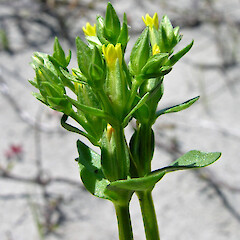Sebaea ovata
Common name
Sebaea
Synonyms
Exacum ovatum Labill., Gentiana ovata Dietr
Family
Gentianaceae
Flora category
Vascular – Native
Endemic taxon
No
Endemic genus
No
Endemic family
No
Structural class
Herbs - Dicotyledons other than Composites
NVS code
The National Vegetation Survey (NVS) Databank is a physical archive and electronic databank containing records of over 94,000 vegetation survey plots - including data from over 19,000 permanent plots. NVS maintains a standard set of species code abbreviations that correspond to standard scientific plant names from the Ngä Tipu o Aotearoa - New Zealand Plants database.
SEBOVA
Chromosome number
2n = c.54
Current conservation status
The conservation status of all known New Zealand vascular plant taxa at the rank of species and below were reassessed in 2017 using the New Zealand Threat Classification System (NZTCS) – more information about this can be found on the NZTCS website. This report includes a statistical summary and brief notes on changes since 2012 and replaces all previous NZTCS lists for vascular plants.
Please note, threat classifications are often suggested by authors when publications fall between NZTCS assessment periods – an interim threat classification status has not been assessed by the NZTCS panel.
- Conservation status of New Zealand indigenous vascular plants, 2017 . 2018. Peter J. de Lange, Jeremy R. Rolfe, John W. Barkla, Shannel P. Courtney, Paul D. Champion, Leon R. Perrie, Sarah M. Beadel, Kerry A. Ford, Ilse Breitwieser, Ines Schönberger, Rowan Hindmarsh-Walls, Peter B. Heenan and Kate Ladley. Department of Conservation. Source: NZTCS and licensed by DOC for reuse under the Creative Commons Attribution 4.0 International licence.
2017 | Threatened – Nationally Critical | Qualifiers: CD, EF, SO
Previous conservation statuses
2012 | Threatened – Nationally Critical | Qualifiers: CD, DP, EF, SO
2009 | Threatened – Nationally Critical | Qualifiers: CD, SO, EF
2004 | Threatened – Nationally Critical
Distribution
Indigenous. In New Zealand formerly known from both North and South Islands, now confined to two natural populations in the North Island near Wanganui, and two deliberately established populations on the remote Pouto Peninsula, near Dargaville. Present also in Australia (South Australia, Victoria, New South Wales and Tasmania) where it is very common.
Habitat
Coastal. Associated with damp, sparsely-vegetated dune slacks, depressions, and associated sand plains. In Australia more widespread, ranging from the coast inland to montane forest, often but not exclusively in seasonally damp ground.
Wetland plant indicator status rating
Information derived from the revised national wetland plant list prepared to assist councils in delineating and monitoring wetlands (Clarkson et al., 2021 Manaaki Whenua – Landcare Research Contract Report LC3975 for Hawke’s Bay Regional Council). The national plant list categorises plants by the extent to which they are found in wetlands and not ‘drylands’. The indicator status ratings are OBL (obligate wetland), FACW (facultative wetland), FAC (facultative), FACU (facultative upland), and UPL (obligate upland). If you have suggestions for the Wetland Indicator Status Rating, please contact: [Enable JavaScript to view protected content]
FACW: Facultative Wetland
Usually is a hydrophyte but occasionally found in uplands (non-wetlands).
Detailed description
Annual, sparingly branched, erect herb, 50-300 mm tall. Stems 4-angled, hairless, pale yellow-green. Leaves, sessile , in opposite pairs, 6.5 x 15 x 5-10 mm, fleshy, pale green to almost blue-green, ovate to broadl-ovate or suborbicular, apex obtuse to subacute, well spaced along stem; midrib prominent, with one conspicuous longitudinal vein either side. Inflorescence a mainly terminal cyme, with a few solitary flowers borne within the subtending leaf axils. Flowers 6.5 mm long, scarcely opening; calyx-lobes 5, narrowly ovate-lanceolate, acute with rigid narrowly winged keel. Corolla tube 4 mm, straight, pale yellow, corolla lobes 5, 3 mm long, pale yellow, linear-lanceolate to lanceolate, often twisted. Ovary 2-locular. Capsules ovoid-ellipsoid, 5 mm long. Seeds fine, dust-like.
Similar taxa
Two introduced weeds, centuary (Centaurium erythraea Rafn. and C. tenuiflorum (Hoffm. et Link) Fritsch) and Blackstonia perfoliata (L.) Hudson occupy the same habitat, and are superfically similar. Centuary can be distinguished by its pink to deep rose flowers, whose anthers spirally twist after anthesis, and by the 1-locular rather than 2-locular ovary. Blackstonia perfoliata is most common in Northland and is much larger than Sebaea and has blue-green, ovate or oblong-ovate, cordate leaves,
Flowering
November - January
Flower colours
Yellow
Fruiting
December - February
Propagation technique
Can be grown from fresh seed. Not especially easy to grow, requiring specialist knowledge to successfully germinate and maintain plants.
Threats
Though formerly ranging from near Hokianga Harbour in the North Island to Lake Ellesmere in the South Island, by the 1980s S. ovata was known from only two sites near Wanganui. At both locations it is seriously at risk from weed encroachment, caused in part by changing water levels in the adjacent dune systems but also due to the release of rabbit calcivirus, which having locally eliminated rabbits, facilitated the spread of weeds normally suppressed by these animals into suitable Sebaea habitat. At both locations Sebaea is being maintained only by diligent management. this management has involved weed spraying and the construction of fresh habitats using a bull dozer.
Story in Trilepidea Issue 28 (March 2006)
Where To Buy
Not commericially available. Plants are held by two botanic gardens, one university and several specialist growers.
Attribution
Fact Sheet prepared by P.J. de Lange 20 October 2003. Description based on Allan (1961) supplemented with observations made from fresh and/or dried herbarium specimens
References and further reading
Allan. H.H. 1961: Flora of New Zealand. Vol. I, Government Printer, Wellington.
Growth and habitat of Sebaea ovata (Gentianaceae) in New Zealand and Australia by P.D. Champion, D.E Hofstra, M.E. Auger, and C.E.C. Gemmill.
NZPCN Fact Sheet citation
Please cite as: de Lange, P.J. (Year at time of access): Sebaea ovata Fact Sheet (content continuously updated). New Zealand Plant Conservation Network. https://www.nzpcn.org.nz/flora/species/sebaea-ovata/ (Date website was queried)








